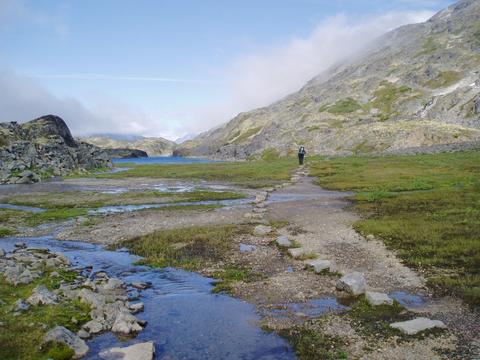Even though the world as a whole is getting smaller and smaller, Alaska still manages to cast an image of being that rugged land far, far away to the north. And yet, quite a few folks are managing to head to Alaska to visit the national parks there.
The national park system as a whole enjoyed an increase in visitation last year, with more than 275 million visitors, and Alaska's national parks played a role in that boost, as they saw nearly a 7 percent increase in visitation.
According to the National Park Service's Alaska Region Office, during 2007 more than 2.6 million folks headed north to Alaska's national parks, up from 2.47 million in 2006. The most popular destination? That was Klondike Gold Rush National Historical Park in Skagway, which attracted 975,043 visitors. Denali National Park and Preserve counted 458,308 visitors, while Glacier Bay National Park and Preserve had 438,211.
"The visitation to Alaska parks reflects the steady increase we have seen in the visitor industry in Alaska," says Alaska Regional Director Marcia Blaszak. "We know that visitors come in large part to see mountains, glaciers, wildlife and history. Alaska's national parks showcase those very things."
OK, but who are those visitors?
John Quinley, the region's assistant director in charge of communications, tells me the typical national park visitor is similar to the typical Alaskan tourist. In other words, the average visitor is 51 years old, enjoys a relatively high household income of more than $80,000, and is more than likely to come from the western United States, as 39 percent of Alaska's visitors come from that region.
Another 19 percent comes from southern states and 13 percent from the Northeast and Midwest, while Canadians comprise 6 percent of the visitors. International visitors represent 9 percent of the total.
Not terribly surprising is the fact that, according to a 2006 survey by the Alaska Travel Industry Association, 94 percent of the state's visitors had been to a national park before they headed north. Eighty-nine percent had some measure of college experience, and 65 percent were empty-nesters.
"A lot of our visitors have a cruise ship ride somewhere in their Alaska itinerary," Ranger Quinley tells me. "Clearly most of the Glacier Bay, Sitka, and Klondike Gold Rush visitation is from cruise passengers (some folks going to all three parks)."
And while visits to remote parks, such as Yukon-Charley Rivers National Preserve, Gates of the Arctic National Park and Preserve, and Bering Land Bridge National Preserve, aren't many, those who do head to such parks typically "stay a long time and invest a significant amount of money in the local economy (with air taxis, lodges or guides)," says the ranger.
"They are doing week-long hikes, fishing trips, sport hunting, etc. Some of the high visitation parks see visitors for a relatively short time (many cruise ships are in Glacier Bay for less than 12 hours)," says Ranger Quinley.
For those folks heading to Alaska this summer, awaiting them will be the new Eielson Visitor Center at Mile 66 of the Denali Park Road. The original visitor center, built in 1960, was demolished in 2005. The new center is larger and more environmentally friendly (it relies on solar and hydro power for much of its electricity) than its predecessor.


 Support Essential Coverage of Essential Places
Support Essential Coverage of Essential Places







Comments
I certainly hope to head back to AK this summer. I hope to visit the remoter parks (Krusenstern, Kobuk Valley, Noatak), even though getting there is a tad more difficult (and expensive).
=========================
My travels through the National Park System: americaincontext.com
I'm going to Denali to go backpacking this summer. It will be my third consecutive annual visit to Alaska, and I hope to keep that trend up. Last year I didn't visit a national park, but a state park. The year before was Wrangell/St Elias. I'd like to visit the more remote parks, and Gates of the Arctic is my goal for next year. But the costs are a challenge. The main reason I'm going to Denali this year is because there is no need to rent a car or hire a plane. I'd rather go somewhere else and avoid the permit system if I could afford it.
I'm trying to hit all of the national parks. I'm a big passport buff. Been at it for 10 years now and for Christmas upgraded to the new large passport. For information on Alaska National Parks see: http://www.ouramericanparks.com/Alaska-National-Parks.html
I've made 2 trips to AK so far and will be going again this year. My first trip was a multi-sport/touring trip that covered from Anchorage to Seward, Lake Clark NP, Whittier, Mat-Su Valley, Denali, and various points in between. Last year I did a raft/hike trip in the Arctic Refuge (Kongakut River); going again this year for same (Hulahula River - Brooks range to Coastal Plain). I love AK and have plans for several more trips , hopefully of at least a month duration.
I am saving & planning, to spend several months in Interior Alaska, to see whether it could work for me to move there. Possibly over this winter.
In the past, I worked as a logger first on Kuiu Island then at Hobart Bay, in Southeast Alaska.
On Kuiu, wolf-packs would position themselves close to the edge of camp (a tiny town), then 'on cue' cut loose with a tremendous din of yipping & squealing and weird noises - trying to lure camp-dogs out into the timber. Unrestrained dogs would often dash immediately for them, and those indoors or tied would struggle to get loose. Dog-owners ran frantically to secure their pets. Those who made it into the brush were considered good as dead.
The Alexander Archipelago of Alaska is especially wilderness-like, even where it is not protected. Other parts of Alaska, I understand, share a good measure of this. The Olympic Peninsula, my home, has a taste of this, and I might like a larger helping.